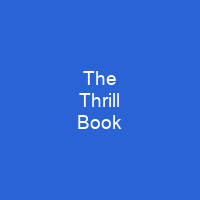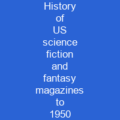The Thrill Book was a U.S. pulp magazine published by Street & Smith in 1919. It was intended to carry stories that were unusual or unclassifiable, which in practice often meant the stories were fantasy or science fiction. The most famous story from The ThrillBook is The Heads of Cerberus, a very early example of a novel about alternative time tracks.
About The Thrill Book in brief
 The Thrill Book was a U.S. pulp magazine published by Street & Smith in 1919. It was intended to carry stories that were unusual or unclassifiable, which in practice often meant the stories were fantasy or science fiction. The first eight issues, edited by Harold Hersey, were a mixture of adventure and weird stories. Contributors included Greye La Spina, Charles Fulton Oursler, J. H. Coryell, and Seabury Quinn. Hersey was replaced by Ronald Oliphant with the July 1 issue, probably because Street and Smith were unhappy with his performance. The last issue was dated October 15, 1919; the magazine was probably cancelled because of poor sales, although a printers’ strike at that time may have been a factor. It has been described as the first American pulp to specialize in fantasy and science fiction, but this description is not supported by recent historians of the field, who regard it instead as a stepping stone on the path that ultimately led to Weird Tales and Amazing Stories, the first true specialized magazines in the fields of weird fiction andScience fiction respectively. The most famous story from The ThrillBook is The Heads of Cerberus, a very early example of a novel about alternative time tracks, by Francis Stevens. The reason he was replaced is not clear, though several explanations have been suggested, including that he was fired for publishing too much of his own fiction and poetry in the magazine; according to Murray Leinster, some of the poetry may have actually been written by Hersey.
The Thrill Book was a U.S. pulp magazine published by Street & Smith in 1919. It was intended to carry stories that were unusual or unclassifiable, which in practice often meant the stories were fantasy or science fiction. The first eight issues, edited by Harold Hersey, were a mixture of adventure and weird stories. Contributors included Greye La Spina, Charles Fulton Oursler, J. H. Coryell, and Seabury Quinn. Hersey was replaced by Ronald Oliphant with the July 1 issue, probably because Street and Smith were unhappy with his performance. The last issue was dated October 15, 1919; the magazine was probably cancelled because of poor sales, although a printers’ strike at that time may have been a factor. It has been described as the first American pulp to specialize in fantasy and science fiction, but this description is not supported by recent historians of the field, who regard it instead as a stepping stone on the path that ultimately led to Weird Tales and Amazing Stories, the first true specialized magazines in the fields of weird fiction andScience fiction respectively. The most famous story from The ThrillBook is The Heads of Cerberus, a very early example of a novel about alternative time tracks, by Francis Stevens. The reason he was replaced is not clear, though several explanations have been suggested, including that he was fired for publishing too much of his own fiction and poetry in the magazine; according to Murray Leinster, some of the poetry may have actually been written by Hersey.
It is possible that Eugene A. Clancy was originally intended to be the editor of the magazine, but was unable to take on the additional work, though Clancy did assist Hersey on some issues of The Thril Book. The choice of a dime novel format was probably a mistake, as it was aimed at readers with low-quality fiction with very low standards. In the late 19th century, popular magazines typically did not print fiction to the exclusion of other content; they would include non-fiction articles and poetry as well. In October 1896, the Frank A. Munsey company’s Argosy magazine was the first to switch to printing only fiction, and in December of that year, it switched to using cheap wood-pulp paper. This is now regarded by magazine historians as having been the start of the pulp magazine era. For twenty years, pulp magazines were successful without restricting their fiction content to any specific genre, but in 1915 the influential magazine publisher Street. & Smith began to issue titles that focused on a particular niche, such as Detective Story Magazine and Western Story Magazine, thus pioneering the specialized and single-genre pulps. In the midst of these changes, some time in 1918, Street &. Smith’s circulation manager, Henry Ralston, decided to launch a new magazine to publish \”different\” stories. The first issue, dated March 1, 1919, was similar to that published in a dime book format.
You want to know more about The Thrill Book?
This page is based on the article The Thrill Book published in Wikipedia (as of Dec. 04, 2020) and was automatically summarized using artificial intelligence.







